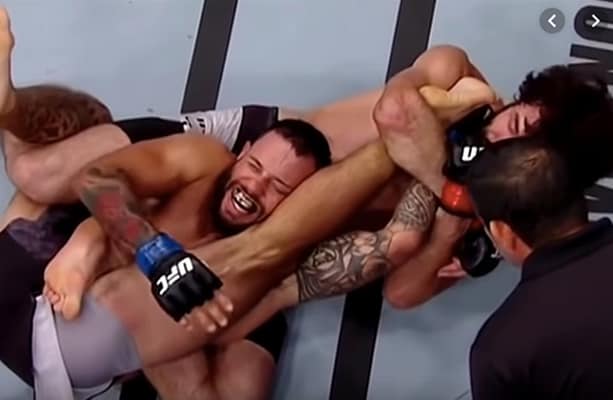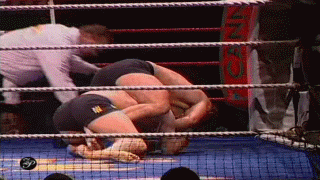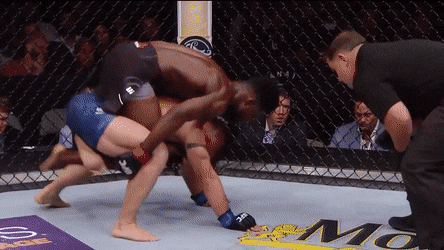
Have you ever heard of the Suloev stretch? Yeah, that’s what I thought. This is one of those moves that very few people know, and even fewer can actually pull off. The trick is not in how complicated the move is – quite the contrary. The only reason why this move and others like it are not taking the grappling world by storm is that they’re not really well known. In that sense, this is the perfect moment to pick up a few pointers on the Suloev stretch and start using it regularly in your rolls and matches.
Whenever BJJ people read “stretch” as part of any move, they tend to look away. It is a fact that Brazilian Jiu-Jitsu grapplers can be elitist in their behavior. Unless certain moves fit all the BJJ requirements Jiu-Jiteros often look shun moves that are actually highly effective. After all, just look at catch wrestling and all it has to offer BJJ. The Suloev Stretch is one of those moves that sound like something out of the WWE. It is, however, a highly legitimate submission hold that doubles as both a joint lock and a muscle stretch/tear submission. It is as evil and painful as it sounds and there’s actually no real secret to setting it up. So, why aren’t we using it more? But, then again, there are other good moves from WWE applicable to BJJ that we’re not used to doing like Dragon Sleeper Hold. Maybe we should consider using some of them more seriously.
What is the Suloev Stretch?
The Suloev Stretch submissions are basically a kneebar submission, but one done from the back. Yes, it ties in two of the best things in Brazilian Jiu-Jitsu: back control and leg locks. Even Danaher himself would be proud of this one. However, the creator behind the Suloev stretch is not the well known BJJ mastermind, but a Russian fighter by the name of Amar Suloev. The late mixed martial artist fought for UFC, Pride, Cage Rage, and M-1 Global. During his time on the mats, he had some impressive victories amassing a 24-7 record. 8 of his victories came in via submissions, with one of them being the Suloev Stretch.
Suloev had a background in kickboxing and Greco Roman wrestling. He came up with the Suloev Stretch submissions during an MMA match with Paul Cathoon under the “2 Hot 2 Handle” banner in 2002.

Suloev himself did not manage to pull it off again in his rich career, which saw him note wins over the likes of Dean Lister, Murilo Bustamante, Hun Kim, and others. However, others have used the submissions, mostly in MMA matches, with great success on every occasion.
How Does it Work?
Let’s break down the mechanics of the Suloev Stretch. In order for the move to work, you first have to establish back control. That said, a word of caution – the tension on the hamstring can come on really quick. Make sure you’re very careful with this one during rolling. That said, once on the back, opponents usually open up the opportunity for the Suloev stretch by turtling up, and trying to shake you off their back. Given that this is a solid percentage escape, it is something you’ll come across often. That makes the Suloev Stretch the perfect answer.
The first point of business you have is staying on the back. When an opponent is tripoding, there’s no risk of foot locks for your self. That means you can cross your ankles freely around their waist. An even tighter and better option is slapping on a full-body triangle to make sure you do not slide off. For the submission itself, you’ll have to pick one leg of the opponent. That can be an easy choice – go for the leg that is straight, and/or closer to you. The goal is to reach for the heel, as far down as possible, and use both your arms to get it.
The goal is to extend the leg, and doing so will require you to roll over. Once you’re on your back, your opponent will be stuck, with their leg fully extended by your pressure on their heel. The position leaves a lot of space to pull with your entire body, which might end up tearing the hamstring muscle. Just to add insult to injury, you could also turn this into a kneebar. Simply place the knee on the opponent’s shoulder, thus getting leverage for a joint lock.
The Suloev Stretch For BJJ – Applications And Ideas

Where does this leave this move in regard to its use in Brazilian Jiu-Jitsu? Well, the fact that this is a leg lock, even though a muscle slicer of a sort, from the back, makes it a very interesting and potentially useful weapon. What is even better is that in Jiu-Jitsu, you don’t have to set it up from back control, Given how much time is spent in turtle in the modern game you can go directly for it. There can be plenty of ways to sneak just one hook in and attack a turtled up opponent with the Suloev Stretch. Not to mention all the potential stand-up uses of the move. A great example is having a rear body lock in when on the feet.
One thing to keep in mind is that this move is nowhere on the map of legal/illegal moves. Certainly, under some rule sets, it will be seen as illegal, so make sure you follow the rules of competition when doing it. Other than that, you can feel free to experiment with it, and even try a lapel version of the move. Be sure to let us know how you do it if you can pull one-off, though.
Closing Thoughts
Submissions like the Suloev Stretch are a great way of introducing some old catch-wrestling style attacks to the modern game of Jiu-Jitsu. In fact, digging up stuff like this is often the key to solving some of the modern-day Jiu-Jitsu puzzles we often struggle with. For me personally, the move is a great way to help me secure back control when an opponent is trying to weasel out, Moreover, it offers a great way to actually transition into full-blown Ashi Garami Leglcoks off of back control, if that is the direction you’re looking for. Plenty of opportunities and a lot of experimentation still left with this one!


![Darce Choke Encyclopedia – Origins, Mechanics and Variations [2025] BJJ, choke, Brabo, BJJ Darce Choke, D'arce Choke, Darce BJJ Choke](https://bjj-world.com/wp-content/uploads/2017/11/JungPoirierLeeYahoo-218x150.jpg)









![Countering with Crab Ride Anthony Budion DVD Review [2025] Countering with Crab Ride Anthony Budion DVD Review](https://bjj-world.com/wp-content/uploads/2025/03/countering-with-crab-ride-anthony-budion-dvd-review-218x150.png)
![Closet Closed Guard Craig Jones DVD Review [2025] Closet Closed Guard Craig Jones DVD Review](https://bjj-world.com/wp-content/uploads/2025/03/closet-closed-guard-craig-jones-dvd-review-218x150.png)
![Xanadu Back Takes Levi Jones-Leary DVD Review [2025] Xanadu Back Takes Levi Jones-Leary DVD Review](https://bjj-world.com/wp-content/uploads/2025/03/xanadu-back-takes-levi-jones-leary-dvd-review-218x150.png)

![No-Gi Grapplers Guide To Front Headlock Joel Bane DVD Review [2025] No-Gi Grapplers Guide To Front Headlock Joel Bane DVD Review](https://bjj-world.com/wp-content/uploads/2025/03/no-gi-front-headlock-joel-bane-dvd-review-218x150.png)

![Kill The Underhook Dima Murovanni DVD Review [2024] Kill The Underhook Dima Murovanni DVD Review](https://bjj-world.com/wp-content/uploads/2024/10/kill-the-underhook-dima-murovanni-dvd-review-324x235.png)


![Mastering Control From Top Position Trent Hidlay DVD Review [2024] Mastering Control From Top Position Trent Hidlay DVD Review](https://bjj-world.com/wp-content/uploads/2024/11/control-from-top-position-trent-hidlay-dvd-review-100x70.png)
![Slay The Wrestle Up Guard Nick Rodriguez DVD Review [2024] Slay The Wrestle Up Guard Nick Rodriguez DVD Review](https://bjj-world.com/wp-content/uploads/2024/12/slay-the-wrestle-up-guard-nick-rodriguez-dvd-review-100x70.png)
![How To Knee Cut Junny Ocasio BJJ DVD Review [2025] How To Knee Cut Junny Ocasio BJJ DVD Review](https://bjj-world.com/wp-content/uploads/2025/02/how-to-knee-cut-junny-ocasio-bjj-dvd-review-100x70.png)

![Effectively Passing The Guard Luke Griffith DVD Review [2025] Effectively Passing The Guard Luke Griffith DVD Review](https://bjj-world.com/wp-content/uploads/2025/01/passing-the-guard-luke-griffith-dvd-review-100x70.png)
![No-Gi Grapplers Guide To Front Headlock Joel Bane DVD Review [2025] No-Gi Grapplers Guide To Front Headlock Joel Bane DVD Review](https://bjj-world.com/wp-content/uploads/2025/03/no-gi-front-headlock-joel-bane-dvd-review-100x70.png)


![Double Sleeve Guard Jon Thomas BJJ DVD Review [2024] Double Sleeve Guard Jon Thomas BJJ DVD Review](https://bjj-world.com/wp-content/uploads/2024/10/double-sleeve-guard-jon-thomas-bjj-dvd-review-100x70.png)

![Just Pass Jay Rodriguez DVD Review [2024] Just Pass Jay Rodriguez DVD Review](https://bjj-world.com/wp-content/uploads/2024/11/just-pass-jay-rodriguez-dvd-review-100x70.png)
![Shin to Shin Eoghan O’Flanagan DVD Review [2025] Shin to Shin Eoghan O'Flanagan DVD Review](https://bjj-world.com/wp-content/uploads/2024/12/shin-to-shin-eoghan-oflanagan-dvd-review-100x70.png)
![Essential Shin To Shin System Shawn Williams DVD Review [2025] Essential Shin To Shin System Shawn Williams DVD Review](https://bjj-world.com/wp-content/uploads/2025/01/shin-to-shin-system-shawn-williams-dvd-review-100x70.png)
![Finish on the Back Ethan Crelinsten DVD Review [2024] Finish on the Back Ethan Crelinsten DVD Review](https://bjj-world.com/wp-content/uploads/2024/10/finish-on-the-back-ethan-crelinsten-dvd-review-100x70.png)





![Simplify the System Side Scissor Brian Glick DVD Review [2024] Simplify the System Side Scissor Brian Glick DVD Review](https://bjj-world.com/wp-content/uploads/2024/09/side-scissor-brian-glick-dvd-review-2024-100x70.png)




![Systematically Attacking The Crucifix Gordon Ryan DVD Review [2024] Systematically Attacking The Crucifix Gordon Ryan DVD Review](https://bjj-world.com/wp-content/uploads/2024/10/systematically-attacking-the-crucifix-gordon-ryan-dvd-review-100x70.png)
![Position And Submission Escapes Craig Funk DVD Review [2025] Position And Submission Escapes Craig Funk DVD Review](https://bjj-world.com/wp-content/uploads/2025/02/position-and-submission-escapes-craig-funk-dvd-review-100x70.png)